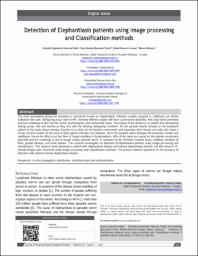Mostrar el registro sencillo del ítem
Detection of Elephantiasis patients using Image processing and Classification methods
| dc.contributor.author | Valencia Olalla, Gricelda Emperatriz | es_ES |
| dc.contributor.author | Bazualdo Fiorini, Enzo Renatto | es_ES |
| dc.contributor.author | Romero-Carazas, Rafael | es_ES |
| dc.contributor.author | Loayza-Enriquez, BK | es_ES |
| dc.date.accessioned | 2023-02-21T14:20:07Z | |
| dc.date.available | 2023-02-21T14:20:07Z | |
| dc.date.issued | 2022-09-29 | |
| dc.identifier.uri | https://hdl.handle.net/20.500.13053/7825 | |
| dc.description.abstract | “The most devastating disease to humanity is commonly known as elephantiasis. Infection usually acquired in childhood but visible indication like pain, disfiguring occur later in life. Severely affected people will have a permanent disability. Not only had it generated physical challenges it also cost for social, psychological, and economical losses. The impact of the disease is so painful and devastating among young men and women as they live with the lifelong disfiguring condition. As the parasite attacks directly to the lymphatic system of the body whose primary function is to drain all the harmful components and impurities from tissues and cells also make a strong immune system of the body to fight against infection and diseases. Since the parasite attack damages the lymphatic vessels and capillaries. Hence the effect is on the flow of lymph resulting in lymphoedema. 90% of the cases are caused by the parasite wuchereria bancrofti and the remaining is due to brugia malayi parasite worm. A symptom of the infection includes tissue swelling, retention of fluid, genital diseases, and acute disease. This research investigates on detection of elephantiasis patients using image processing and classification. This research work represents a patient with elephantiasis disease and without elephantiasis disease. For this research 35, sample images were examined using image processing with classification methods. The present research represents 91.4% accuracy of detection with patients having elephantiasis disease.“ | es_ES |
| dc.format | application/pdf | es_ES |
| dc.language.iso | eng | es_ES |
| dc.publisher | ResearchTrentz Academy Publishing Education Services | es_ES |
| dc.rights | info:eu-repo/semantics/openAccess | es_ES |
| dc.rights.uri | https://creativecommons.org/licenses/by/4.0/ | es_ES |
| dc.subject | in vitro propagation, disinfection, phytohormones and acclimatization | es_ES |
| dc.title | Detection of Elephantiasis patients using Image processing and Classification methods | es_ES |
| dc.type | info:eu-repo/semantics/article | es_ES |
| dc.type.version | info:eu-repo/semantics/publishedVersion | es_ES |
| dc.publisher.country | IN | es_ES |
| dc.subject.ocde | http://purl.org/pe-repo/ocde/ford#3.03.00 | es_ES |
Ficheros en el ítem
Este ítem aparece en la(s) siguiente(s) colección(es)
-
Web of Science (WOS) [236]


